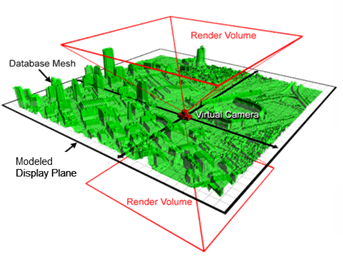Hogel
A hogel (a portmanteau of the words holographic and element) is a part of a light-field hologram, in particular a computer-generated one. In contrast to 2D pixels, hogels contain the direction and intensity of light rays from many perspectives, and is in essence what is referred to as a micro-image in plenoptic imaging terms. Synthetic hogels are typically rendered through double-frustum, oblique slice & dice or polygonal/voxel ray-tracing/ray-casting. Research into efficient generation and compression of hogels may allow holographic displays to become more widely available.
An array of hogels can be used to reconstruct a light-field by emitting light through a microlens array or by reflective/transmissive photo-polymer holograms.

The term "hogel" was coined by Mark Lucente who first used it in his 1994 MIT Doctoral Thesis Dissertation.[1]
More recent examples include a paper presented at the SMPTE 2nd Annual International Conference on Stereoscopic 3D for Media and Entertainment entitled "The First 20 Years of Holographic Video – and the Next 20",[2] or in these recent book chapters: "Electronic Holography -- 20 Years of Interactive Spatial Imaging" in Handbook of Visual Display Technology[3] , and "Computational Display Holography" in Holographic Imaging.[4]
References
- ↑ Lucente, Mark. "Diffraction-Specific Fringe Computation for Electro-Holography". MIT Dept. of Electrical Engineering and Computer Science. Retrieved Sep 1994. Check date values in:
|access-date=(help) See, for example, page 55 in "Chapter 4: Diffraction-Specific Computation", or the "Glossary of Terms and Abbreviations" in Appendix A on page 151. - ↑ Lucente, Mark. "The First 20 Years of Holographic Video -- and the Next 20" (PDF). Society of Motion Picture and Television Engineers (SMPTE).
- ↑ Chen (2011). Handbook of Visual Display Technology. Springer-Verlag. ISBN 978-3-540-79566-7.
- ↑ Benton, Stephen A. (2008). Computational Display Holography. Wiley-Interscience. ISBN 978-0-470-06806-9.
External links
- A video showing the rapid writing time of the 3D display system
- Hogel Rendering
- Hogel Rendering Performance
- 3D hogel render video
Further reading
- "Holographic three-dimensional telepresence using large-area photorefractive polymer". Nature 468:80-83. 4 November 2010. doi:10.1038/nature09521.
- Klug, M., Burnett, T., Fancello, A., Heath, A., Gardner, K., O'Connell, S., Newswanger, C. (2013). "A Scalable, Collaborative, Interactive Light-field Display System", SID Symposium Digest of Technical Papers